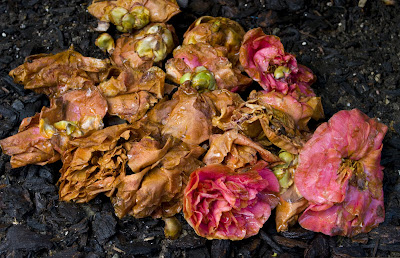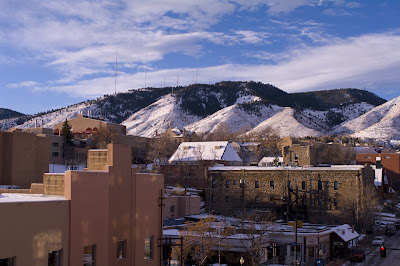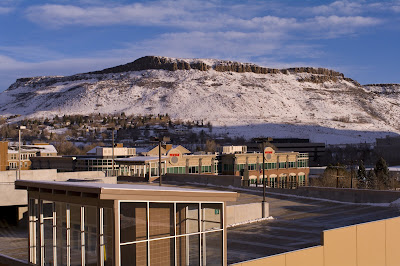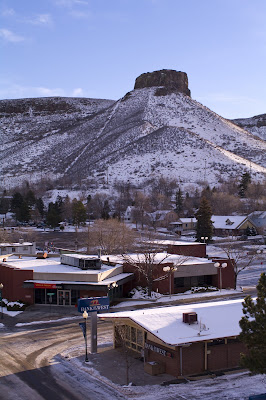
|
|
|---|
Tuesday, January 27, 2009
Sunday, January 25, 2009
Last Bloom of Camellias
Saturday, January 24, 2009
Tempest in a Teapot?

I recognized that by posting my purchase and comments on the Leica D-Lux 4 might stir the simmering juices of the cauldrons (dictionary definition: "a large vessel used for boiling") which we affectionately refer to as web forums today. Of the various comments I've read so far, Richard Day's reaction is the sanest and most level-headed, to which I owe him a thank you.
Obviously this is my personal post, but I recognize I have to carefully navigate between my personal observations and what might be construed as representative of the thoughts or views of the company. To this end, and not because I was told to do this, I thought I'd share some comments about my D-Lux post and respond to some of your reactions.
To those that say it's incredible (or stupid or worse) that I would acknowledge buying another brand camera, please refer to the camera market chart above. As you can see, the D-Lux falls into a category that we do not participate in. Of course when I'm surfing or near the water, I carry and thoroughly enjoy my W60. Like wise, as you all know from my posts here, I'm very active testing and shooting with our SLR's.
For those of you that are old enough to remember film, my fascination with the D-Lux 4 is very analagous to those days when many working photographers, regardless of whether they shot with Canon, Nikon or Pentax SLR's, also owned a Contax T2 or T3 for those times they wanted to travel light yet still have a camera that gave them very high-quality results.
As I have been active with this blog for several years, I would assume most of you recognize that being an active photographer, I also view it my responsibility to be the "voice of the customer" and really try to understand what drives our passion for photography, as well as truly understand our wants and needs. With this in mind, it's incredibly important for me to understand and evaluate what other companies are doing in the photography market. By acknowledging that I am now shooting with the D-Lux should actually be viewed as a positive. Would you rather have me cloistered in a dark room oblivious to the trends in the market and the direction that our competitors are heading? By comparison, I heard that when Honda starting shipping the Accord, General Motors forbid any of the senior management to drive or own this car. In hindsight, it's clear someone in Detroit should have had their eyes wide-open.
I also realized that my desire for a high-quality compact camera that offered near-SLR quality was probably shared by a few other Pentaxians. After posting this blog entry on the Leica forum of dpreview, it was interesting that several folks have already bought the D-Lux 4 or the Panasonic equivalent LX3. If there was any method to my madness in publishing this post, could it be that I was just throwing a lure out on the calm waters of lake pentax to see if anyone took the bait, or what your interest in this type of product would be?
In closing, I hope that a few of you now recognize the "intent" of my post about the D-Lux 4. At the very least, give me credit for being a "photographer first" and recognize that this passion and knowledge is not necessarily a bad thing if you are in the business of making cameras :-)
Friday, January 23, 2009
Leica D-Lux 4

My 42 year old Leica M4 has a new companion to keep it company in my original Domke bag!
I travel often on business and prefer to carry a minimum of gear. The last few months I've obsessed about having a compact camera with SLR-like image quality and sharp optics.
A week ago, I finally decided to buy the Leica D-Lux 4. Thanks to the great service at B&H, I ordered the camera on Wednesday night, had it in my hands Friday and then promptly flew off to Japan last Sunday. I didn't have much time to play with my new camera, but was able to spend an hour and half walking around with the camera Friday morning near the Ikebukuro station, in Tokyo. By coincidence, they were having some type of disaster readiness drill, so it gave me an interesting event to photograph with the D-Lux 4. While I always shoot in RAW, I don't believe CS3 supports the camera yet, so I had no choice but to test out the camera's JPEG setting.
Overall, I'm really impressed with this little gem. It's truly pocketable, the interface and controls are well thought out. I really like the focus option allowing you to move the point to any part of the scene, thus eliminating the need to focus and recompose. The lens is very sharp and distortion seems to be very well controlled. And, I was pleasantly surprised with the JPEGs from this first outing. Colors are spot on, with a pleasing and natural saturation.
While there are a few things about the D-Lux 4 (like the easily turned Mode dial) that could be better, this camera comes very close to satisfying my desire for a compact camera featuring high quality optics and manual controls that I can slip into my briefcase and take with me anywhere.
Note 1: All photos shot in Standard JPEG setting. I kept ISO at 200 or 400. Aperture varied between f/4.0 and f/5.6. Exposures ranged from 1/20 to 1/200. Except for minor cropping on three photos, and setting the black and white points (levels) using CS3, I didn't do any post processing to these JPEGs.
Note 2: The last photo is not part of the disaster readiness exercise, but I thought it was a nice example of the sharpness of the D-Lux 4 lens. This is a store display for an opticians shop near my hotel.
Note 3: Click on any of these thumbnails to see a larger file.
Thursday, January 22, 2009
January 22, 2009 - Method in the Madness?
 I’ve been in Bradenton Beach, Florida this week, attending The Homiletical Feast – a preaching conference I attend each year. Not that Florida has offered any balmy weather: it’s been as low as 32 degrees here this week. The exegetical papers we’ve considered in the group have been high-quality, as usual, and the discussion and mutual support has been more valuable than words can say.
I’ve been in Bradenton Beach, Florida this week, attending The Homiletical Feast – a preaching conference I attend each year. Not that Florida has offered any balmy weather: it’s been as low as 32 degrees here this week. The exegetical papers we’ve considered in the group have been high-quality, as usual, and the discussion and mutual support has been more valuable than words can say.These 16 or so ministers are among my most valued colleagues. Over the years, they’ve become friends as well. We only meet once a year, but the four days we spend together are a time of talking, sharing and supporting one another, as we reflect on this demanding occupation.
Earlier today, one of my colleagues shared a poem by Larry Smith called “What You Realize When Cancer Comes.” He found it on Garrison Keillor’s The Writer’s Almanac program on American Public Radio. Here’s an excerpt:
“You will not live forever – No
you will not, for a ceiling of clouds
hovers in the sky.
 You are not as brave
You are not as braveas you once thought.
Sounds of death
echo in your chest.
You feel the bite of pain,
the taste of it running
through you.
Following the telling to friends
comes a silence of
felt goodbyes. You come to know
the welling of tears.
Your children are stronger
than you thought and
closer to your skin.
The beauty of animals
birds on telephone lines,
dogs who look into your eyes,
all bring you peace.”
 The poem ends with these words:
The poem ends with these words:“You are in a river
flowing in and through you.
Take a breath. Reach out your arms.
You can survive.
A river is flowing
flowing in and through you.
Take a breath. Reach out your arms.”
The poem causes me to reflect on many of the things I’ve lived through, these past three years or so. One of the things I’ve struggled with, off and on, is the question: “Why?” What purpose is there in all this?
Smith’s poem captures the transformational aspect of cancer. When those of us who undertake this journey – however unwillingly – complete it, we are not the same people as when we began. Every step we take along the road changes us.
Thinking theologically, I’m led to ask once again what long-term purpose God may have in mind for my ministry. In allowing me to get this disease, curing me from its aggressive variety, then miring me in the interminable limbo of indolent lymphoma’s “watch and wait,” what’s God’s point? If it’s true, as we Presbyterians are inclined to think, that God calls men and women to ministry, then what call could there possibly be in cancer?
The Larry Smith poem suggests some possible reasons. “You will not live forever.” I have a visceral awareness of this truth, now, that has hitherto been a mere abstraction. “You are not as brave as you once thought.” No, indeed I’m not. I’m learning to live with uncertainty, and still rise to the challenges of daily living. “You can survive.” Yes, I can. I’m doing it. One day at a time.
I’ve had some difficulty sensing God’s will in the midst of follicular lymphoma. Aggressive cancer I can understand: it’s a challenge to be met, or die trying. Cured cancer I can likewise understand: it’s a triumph to be celebrated. But, this neither-here-nor-there, neither healthy-nor-unhealthy limbo, stretching on into the interminable future: what’s God up to?
Maybe the purpose is to nurture my empathy, my ability to connect with others. I’m not the only person whose life is fraught with ambiguity, is lived out in the gray country of uncertainty. Maybe I’m meant to be a fellow-traveler and accompany others. Maybe I’ve been enrolled in a school of perseverance, so I may help others persevere.

Ugh!
Yesterday Ronan made the observation that stars are naked. I love it! I shall leave that with you until I can get my updates posted. Cheers!
Ugh!
Yesterday Ronan made the observation that stars are naked. I love it! I shall leave that with you until I can get my updates posted. Cheers!
Monday, January 19, 2009
(01.19.09) Recommends:
We learned about Ericailcane this weekend while we were walking down LaBrea. If you've been around LaBrea and Melrose lately perhaps you've seen this giant [some type of animal(1)] eating a car:
Further research revealed that this mural went up as part of Ericailcane's new show Man Is The Bastard at the nearby Carmichael Gallery. The gallery has a nice, er, gallery of photos from the show up on the website, if you can't see it in person.
But lovers of whimsical ink on paper work should give Ericailane a try.
(1) We use the term 'animal' with some trepidation since it appears to be wearing a very civilized pair of shoes.
WDI Alumni Wins World Title

It was a great day for Romania and for Dan Cristea. They won the English Second Language world debating title at the 2009 World Universities Debating Championships held in Cork, Ireland at the beginning of January.
Dan attended WDI as a high school student from Romania. "It is really where I got my start with debating, and I will never forget it," he recalled in Cork while talking to WDI director Snider.
Dan now debates for Babes-Bolyai University . He and his partner, Nicoleta Lupea , are also European champions in the same category.
Congratulations to Dan, and glad you got your start here at WDI.
Friday, January 16, 2009
January 16, 2009 - Leadership: It's Personal
 The recent news about entrepreneur Steve Jobs’ sudden medical leave from Apple Computer brings back memories for me. When you’re in a very public sort of job – like CEO of a company, or pastor of a congregation – there isn’t much of a right to privacy. You’re doing more, professionally, than just filling a box on an organization chart. Personality and profession are all wrapped up together. When you get sick, people feel they need to know.
The recent news about entrepreneur Steve Jobs’ sudden medical leave from Apple Computer brings back memories for me. When you’re in a very public sort of job – like CEO of a company, or pastor of a congregation – there isn’t much of a right to privacy. You’re doing more, professionally, than just filling a box on an organization chart. Personality and profession are all wrapped up together. When you get sick, people feel they need to know.Steve Jobs has pancreatic cancer. So far, he’s been one of the truly fortunate ones. Not only is he still around, more than 4 years later, but – except for several relatively brief absences – he’s thrived, remaining at the helm of the innovative company he founded. Now, Mr. Jobs has announced he’s taking another, longer leave to see to medical concerns – at least until June.
Apple stock has plummeted. It must be a terribly difficult spot to be in, knowing the stock analysts are watching him like hawks (or vultures?), ready to issue “sell” orders at the least sign of physical weakness. For a man like Steve Jobs, even getting the flu could have a notable effect on his company’s value. The fact that he’s actually stepping down for a time indicates that something is, indeed, seriously amiss.
 At least one commentator has issued a call to privacy on his behalf. I agree with that. News reports speculating about the future of the company and the value of its stock are inevitable, I suppose, but it would be nice if the media could find some way to discharge their duty to the public without heating up Mr. Jobs’ life with their spotlights. He needs to find a place of peace and privacy where he can concentrate on healing.
At least one commentator has issued a call to privacy on his behalf. I agree with that. News reports speculating about the future of the company and the value of its stock are inevitable, I suppose, but it would be nice if the media could find some way to discharge their duty to the public without heating up Mr. Jobs’ life with their spotlights. He needs to find a place of peace and privacy where he can concentrate on healing.I’m grateful that my congregation gave me such a place, during the acute phase of my illness. I used this blog to let them know how things were going, but that was my choice to do so. This online journal has also been a kind of therapy for me, providing a way to reflect personally and theologically on what’s been happening to me, and what God is doing in my life.
Sometimes I wonder, though, whether certain developments in the life of the church may be attributable to my cancer. As we struggle with issues of membership growth and finances, as nearly all mainline Protestant churches are doing these days, I ask myself whether some of this church’s particular challenges are attributable to my health outlook. Has this become “the church whose pastor has cancer,” in some people’s minds? How does my health situation affect long-range planning? Did the intense focus on my health back when I was receiving chemotherapy – as God’s people ministered to their minister – help or hinder the church’s overall mission in the long run?
 These are mostly unanswerable questions. As with families, churches sometimes find they can’t choose or plan for certain eventualities. They have to face whatever comes.
These are mostly unanswerable questions. As with families, churches sometimes find they can’t choose or plan for certain eventualities. They have to face whatever comes.Still, the questions remain in my mind. Leadership is personal – and nowhere is this more true than in ministry.
Thursday, January 15, 2009
January 15, 2009 - Retirement Planning
 Yesterday, Claire and I returned from Princeton Theological Seminary, where we attended a two-and-a-half-day Pre-Retirement Seminar sponsored by the Presbyterian Church’s Board of Pensions. Not that we have plans to retire anytime soon. That, God-willing-and-the-cancer-don’t-flare-up, is 15 years off at least. We went because the Board of Pensions encourages ministers over 50 to attend one of these conferences, and to bring their spouses with them. The idea is to get a head start on long-term financial planning.
Yesterday, Claire and I returned from Princeton Theological Seminary, where we attended a two-and-a-half-day Pre-Retirement Seminar sponsored by the Presbyterian Church’s Board of Pensions. Not that we have plans to retire anytime soon. That, God-willing-and-the-cancer-don’t-flare-up, is 15 years off at least. We went because the Board of Pensions encourages ministers over 50 to attend one of these conferences, and to bring their spouses with them. The idea is to get a head start on long-term financial planning.The Presbyterian Church has a mighty good pension plan. It’s fully funded, and conservatively run – something we plan members surely appreciate in uncertain times like these. The sticky wicket, for those of us pastors who live in manses, is where we’ll live in retirement. The Board’s encouraging us to start thinking about the answer to that question now.
 Claire and I found it a positive experience. The leadership – especially the financial-planning speaker – was excellent. Just what we budget-challenged liberal-arts graduates needed, even if it did feel odd to be thinking about retirement in our prime working years.
Claire and I found it a positive experience. The leadership – especially the financial-planning speaker – was excellent. Just what we budget-challenged liberal-arts graduates needed, even if it did feel odd to be thinking about retirement in our prime working years.There were 20 or so participants, all told. Ages ranged from people in their early 50s, like us, to one man who’s just a few months from the proverbial gold watch.
My active cancer diagnosis sets me apart from my fellow participants. Will I make it to age 66 and 4 months – the threshold when Americans in my birth year can collect full Social Security benefits? Or, will disability be staring me down sometime before then, as a stem-cell transplant or some other treatment looms? If disability is in my future, will I recover fully after treatment and return to full-time ministry? So many unanswerable questions...
 The more time I put between myself and the aggressive large B-cell lymphoma I once had, the more retirement planning makes sense. Indolent NHL is kinder, that way. When Dr. Lerner assures me I could still be doing the watch-and-wait thing years from now, I take him at his word - which is why I can even go to a conference like this in the first place.
The more time I put between myself and the aggressive large B-cell lymphoma I once had, the more retirement planning makes sense. Indolent NHL is kinder, that way. When Dr. Lerner assures me I could still be doing the watch-and-wait thing years from now, I take him at his word - which is why I can even go to a conference like this in the first place.Questions like these are, of course, imponderable. The only thing to do is to plan for the best-case scenario, and hope I’m prepared for anything worse that may come my way.
The conference program also included a presentation on maintaining personal health. I’ll be the first to admit I’ve got a long way to go in that area. I’m vigilant about anything cancer-related, of course, but anyone who knows me knows the diet-and-exercise thing is a tough sell. The spirit is willing on that one, but the flesh is weak.
So, Claire and I left Princeton with a lot to think about. One of the benefits of this particular meeting was that it encouraged us in ministry – that most other-directed of occupations – to try thinking about ourselves, and taking care of ourselves, for a change.
Point well taken, Board of Pensions. I’ll try to do better.

Tuesday, January 13, 2009
Downtown Golden, CO
Sorry for the delay... new stuff afoot
I'm slowly making some changes to the blog I hope you enjoy. There are many posts this week so be sure to click the "older blogs" links if you get to the bottom of this page, there are still more to come.
Hugs and love,
Ayla
Sorry for the delay... new stuff afoot
I'm slowly making some changes to the blog I hope you enjoy. There are many posts this week so be sure to click the "older blogs" links if you get to the bottom of this page, there are still more to come.
Hugs and love,
Ayla
Nature Crafting - Hand Sewing
I love my sewing machine as much as the next gal but I also like to hand sew. That way when the electric grid goes down I will have beautiful, well practiced stitches - ha ha - but seriously, slowing down a bit and becoming intimate with each stitch is a calming and meditative experience. Sometimes I feel too rushed on my machine and I can't get into the same groove that a practice such as knitting or painting is perfect for. That's when I slow down, sit down, and hand sew. *release a deep breath*
Nature Crafting - Hand Sewing
I love my sewing machine as much as the next gal but I also like to hand sew. That way when the electric grid goes down I will have beautiful, well practiced stitches - ha ha - but seriously, slowing down a bit and becoming intimate with each stitch is a calming and meditative experience. Sometimes I feel too rushed on my machine and I can't get into the same groove that a practice such as knitting or painting is perfect for. That's when I slow down, sit down, and hand sew. *release a deep breath*
Mor'moonism - Abraham and the Goddess Inanna as Kolob
From the ancient records of the Sumerian peoples we can gain insight into the world which Abraham was born. We also have the Book of Abraham as translated from the papyrus scrolls by our Prophet/Shaman Joseph Smith.
The religious histories tell us that Abraham was born in the city of Ur a thriving village of Summer. The exact date is not well known. Working with lineages from the bible scholars place Abraham somewhere between 2000 - 1500 BCE. This corresponds with the time of the rule of the Queen of Heaven in Ur, Inanna, to which the Sumerian literature of the time is deeply devoted.
It is certain that Abraham could not have avoided the influence of the the Goddess of Heaven and Earth. The Goddess of love, Inanna, was Sumer's most beloved and revered deity. Since as far back as 2000 BCE Sumerian tales, legends and songs to her were inscribed on clay tablets and fragments now scattered throughout museums all over the world (Kramer xiii).
Abraham would have been raised on the stories of Inanna such as the Huluppu-Tree, which closely reflects the story of the Garden of Eden in Genesis, and other spiritual tales such as The Courtship of Inanna and Dumuzi, in which the Goddess takes a lover, and the well known Decent of Inanna where Inanna travels to the underworld.
Inanna is the daughter of Nanna, the moon God and Ningal the moon Goddess, both of whom are descendant from Ki, also known as Urash, the Earth Goddess, An the sky God and Nammu the Goddess of the watery deep. She is the sister of Utu the sun God and the wife and lover of Dumuzi the Shepard-King of Uruk who has been compared to Jesus Christ. Some authors even place the Dumuzi tale as a prelude to the story of Christ.
Certainly the similarities don't end there. In the tale of the Huluppu-tree a dark maiden named Lilith built her home in the trunk of the serpent dripping Huluppa-tree. This is the first historical mention of Lilith, predating the Hebrew bible in which Lilith is the first wife of Adam in the garden of Eden. Her refusal to submit to him ends in her exile from the garden.
Ur, also called Chaldeas in the scriptures, was a land of myth, magic and devotion to the Divine Feminine. This is the soil from which Abraham grew. So then when Abraham decided to follow Elohim and leave his home for time spent in the land of Caanan and Eygpt - did he leave as a rebel against the the Goddess or a supporter of Her?
It would seem from the records we have today, the bible, the Torah and the Koran that Abraham was the founder of monotheism and believed in only one, male, God. It would also seem that he is the patriarch of all patriarchs whose adventures established three of the most male ruled religions the world has ever know. Could he have been anything but an enemy of the Divine Feminine? I would argue, yes, in fact I would call him friend of the Goddess in a round about sort of way.
From the traditional scriptures of Christianity, Islam and Judaism we have little record of Abraham's time spent in Egypt. However in the 1800's the American Prophet and Shaman, Joseph Smith, who taught his followers that we have a mother in Heaven as well as a father, translated from papyrus Abraham's own writings from his time spent in Egypt.
The first two chapters of this text follow much of the biblical story of Abraham being commanded by God to leave Ur. Abraham tells of becoming a High Priest, a rightful heir holding the right belonging to the fathers. He speaks of his people who worship the heathen gods and refuse to harken to his voice. The heathen gods he speaks of are the "the god, of Pharaoh, King of Egypt." Abraham 1; 6.
Abraham also explains that these adorers of dumb idols were sacrificing their children as well as young virgins. Now this sort of description can be taken many ways. One might think on the surface of things that Abraham is speaking against the Gods and by extension the Goddesses of his homeland of Sumer, however we can clearly see by reading the text in detail he is speaking of the Egyptian Gods and idols.
Abraham, his wife Sarai and their nephew Lot leave Ur of Chaldeas and end up in Egypt. In chapter three we see a shift from the biblical account to the new information we are gaining from this translation. Abraham learns about the sun, the moon and the stars by way of the Urim and the Thummim. The Urim and the Thummim being the peep stones with which Joseph Smith, their eventual owner uses to translate the Mormon scriptures.
We find that the Urim and the Thummim were given to Abraham by God and that they came from Ur. I find it amazing that the peep stones so magickaly used to give us the Mormon scriptures of these latter-days came from the land of the Goddess Inanna during a time when her worship was at it height!
Chapter three of the Book of Abraham goes on to give an account of Abraham speaking to the Lord. The Lord tells him that the name of the great star, near to his throne is Kolob and that the Lord has set Kolob to govern all those which belong to the same order as that upon which Abraham standest.
Inanna was known as the Queen of Heaven, the morning and evening star. I would propose that the Lord is here speaking of his Lady, Inanna, the Queen of Heaven sitting nearest to the throne of the Lord as his Lady. She is set to govern all those whose faith sprang from Abraham - those who stand on or build off of Abraham's faith and records.
The Sun and Moon are described as planets set by God to rule the day and night of those standing upon the earth in Abraham 3; 5-6. The notion of standing upon the Earth is also a curious use of words. I interpret that to mean that not just the seed of Abraham are to be ruled by Inanna, as the star Kolob, but more importantly the seed of Abraham who stand upon the Earth - who stand for the Earth. Those who are rooted to their Earth, who's feet stand upon the Earth walking lightly, in pleasure and reverence.
In chapter three verse nine it is written; "And thus there shall be the reckoning of the time of one planet above another, until thou come nigh unto Kolob, which Kolob is after the reckoning of the Lords's time; which Kolob is set nigh unto the throne of God, to govern all those planets which belong to the same order as that upon which thou standest."
I interpret that verse to mean; there shall be a time when either the sun is above the moon. A time when the masculine (the sun) will outrank the feminine (the moon) causing imbalance. This is when we must come unto Kolob, who is Inanna, which will come after the Lord's time, or the time when the worship of a male Lord dominated religious thought and devotion. Yet Kolob, Inanna, is still set on the throne of God, for She is the Goddess, governing all those energies in the Universe who are of the same lineage of Abraham. That lineage being those who reject the sacrifical, idol Gods in favor of holding the Lord and Lady in their glory place upon the throne of Heaven.
The Lord goes on to name the sun Shinehah, the moon Olea and all the stars Kokaubeam, Kolob being the greatest of those stars. When thinking about the view from our planet the greatest star is often Venus, shinning brightly. Inanna is also celebrated as Venus for which she is named the Morning and Evening Star.
The Lord continues to say that, "Kolob is the greatest of all the Kokaubeam that thou hast seen, because it is nearest unto me." Who else would be nearest to the Father but the Mother? The Book of Abraham ends saying many times that this is all the information that can be presented in the present day, which was the early-mid 1800's. This furthers my personal theory that Mormon scriptures were meant as a transition from the male dominated traditions within Western religion to a balanced male and female tradition bringing together the true lessons of Christianity as well as the truth of past Goddess worship.
Joesph Smith revealed slowly information such as the existence of a Heavenly Mother and giving women the priesthood (or it may very well have been delivered to him by our Heavenly Parents slowly) so as to gently transition the world back to a balanced look at the Divine Masculine and Feminine.
Who was Abraham then? I believe he was the carrier of the patriarchal information, the preserver of the Divine Masculine that without the Divine Feminine has gone completely askew for the past 6,000 years. The keeper and carrier of the Divine Feminine took many paths, perhaps in Sarai, Abraham's wife, and certainly in Mary Magdalen and in the art, literature and rituals of our ancestors. We all carry the Mother in our collective soul-body and whether She was meant to go underground or was forced underground by an out of control patriarchy I cannot say. Perhaps it was a little of both.
It is upon us then to bring her back, the Queen of Heaven, the Morning Star, Kolob - She who shares the throne of Heaven, the Lady to our Lord - the Great Mother of us all. Blessed Be
Works Cited
Kramer, Samuel and Wolkstein, Diane. Inanna, Queen of Heaven and Earth, Her Stories and Hymns From Sumer, Harper and Row Publishers, New York, 1983.
Szulc, Tad. Abraham, Journey of Faith, National Geographic Magazine, December 2001.
Smith, Joseph. The Pearl of Great Price. Published by the Church of Jesus Christ of Latter-day Saints, Sal Lake City, UT, 1979.
Mor'moonism - Abraham and the Goddess Inanna as Kolob
From the ancient records of the Sumerian peoples we can gain insight into the world which Abraham was born. We also have the Book of Abraham as translated from the papyrus scrolls by our Prophet/Shaman Joseph Smith.
The religious histories tell us that Abraham was born in the city of Ur a thriving village of Summer. The exact date is not well known. Working with lineages from the bible scholars place Abraham somewhere between 2000 - 1500 BCE. This corresponds with the time of the rule of the Queen of Heaven in Ur, Inanna, to which the Sumerian literature of the time is deeply devoted.
It is certain that Abraham could not have avoided the influence of the the Goddess of Heaven and Earth. The Goddess of love, Inanna, was Sumer's most beloved and revered deity. Since as far back as 2000 BCE Sumerian tales, legends and songs to her were inscribed on clay tablets and fragments now scattered throughout museums all over the world (Kramer xiii).
Abraham would have been raised on the stories of Inanna such as the Huluppu-Tree, which closely reflects the story of the Garden of Eden in Genesis, and other spiritual tales such as The Courtship of Inanna and Dumuzi, in which the Goddess takes a lover, and the well known Decent of Inanna where Inanna travels to the underworld.
Inanna is the daughter of Nanna, the moon God and Ningal the moon Goddess, both of whom are descendant from Ki, also known as Urash, the Earth Goddess, An the sky God and Nammu the Goddess of the watery deep. She is the sister of Utu the sun God and the wife and lover of Dumuzi the Shepard-King of Uruk who has been compared to Jesus Christ. Some authors even place the Dumuzi tale as a prelude to the story of Christ.
Certainly the similarities don't end there. In the tale of the Huluppu-tree a dark maiden named Lilith built her home in the trunk of the serpent dripping Huluppa-tree. This is the first historical mention of Lilith, predating the Hebrew bible in which Lilith is the first wife of Adam in the garden of Eden. Her refusal to submit to him ends in her exile from the garden.
Ur, also called Chaldeas in the scriptures, was a land of myth, magic and devotion to the Divine Feminine. This is the soil from which Abraham grew. So then when Abraham decided to follow Elohim and leave his home for time spent in the land of Caanan and Eygpt - did he leave as a rebel against the the Goddess or a supporter of Her?
It would seem from the records we have today, the bible, the Torah and the Koran that Abraham was the founder of monotheism and believed in only one, male, God. It would also seem that he is the patriarch of all patriarchs whose adventures established three of the most male ruled religions the world has ever know. Could he have been anything but an enemy of the Divine Feminine? I would argue, yes, in fact I would call him friend of the Goddess in a round about sort of way.
From the traditional scriptures of Christianity, Islam and Judaism we have little record of Abraham's time spent in Egypt. However in the 1800's the American Prophet and Shaman, Joseph Smith, who taught his followers that we have a mother in Heaven as well as a father, translated from papyrus Abraham's own writings from his time spent in Egypt.
The first two chapters of this text follow much of the biblical story of Abraham being commanded by God to leave Ur. Abraham tells of becoming a High Priest, a rightful heir holding the right belonging to the fathers. He speaks of his people who worship the heathen gods and refuse to harken to his voice. The heathen gods he speaks of are the "the god, of Pharaoh, King of Egypt." Abraham 1; 6.
Abraham also explains that these adorers of dumb idols were sacrificing their children as well as young virgins. Now this sort of description can be taken many ways. One might think on the surface of things that Abraham is speaking against the Gods and by extension the Goddesses of his homeland of Sumer, however we can clearly see by reading the text in detail he is speaking of the Egyptian Gods and idols.
Abraham, his wife Sarai and their nephew Lot leave Ur of Chaldeas and end up in Egypt. In chapter three we see a shift from the biblical account to the new information we are gaining from this translation. Abraham learns about the sun, the moon and the stars by way of the Urim and the Thummim. The Urim and the Thummim being the peep stones with which Joseph Smith, their eventual owner uses to translate the Mormon scriptures.
We find that the Urim and the Thummim were given to Abraham by God and that they came from Ur. I find it amazing that the peep stones so magickaly used to give us the Mormon scriptures of these latter-days came from the land of the Goddess Inanna during a time when her worship was at it height!
Chapter three of the Book of Abraham goes on to give an account of Abraham speaking to the Lord. The Lord tells him that the name of the great star, near to his throne is Kolob and that the Lord has set Kolob to govern all those which belong to the same order as that upon which Abraham standest.
Inanna was known as the Queen of Heaven, the morning and evening star. I would propose that the Lord is here speaking of his Lady, Inanna, the Queen of Heaven sitting nearest to the throne of the Lord as his Lady. She is set to govern all those whose faith sprang from Abraham - those who stand on or build off of Abraham's faith and records.
The Sun and Moon are described as planets set by God to rule the day and night of those standing upon the earth in Abraham 3; 5-6. The notion of standing upon the Earth is also a curious use of words. I interpret that to mean that not just the seed of Abraham are to be ruled by Inanna, as the star Kolob, but more importantly the seed of Abraham who stand upon the Earth - who stand for the Earth. Those who are rooted to their Earth, who's feet stand upon the Earth walking lightly, in pleasure and reverence.
In chapter three verse nine it is written; "And thus there shall be the reckoning of the time of one planet above another, until thou come nigh unto Kolob, which Kolob is after the reckoning of the Lords's time; which Kolob is set nigh unto the throne of God, to govern all those planets which belong to the same order as that upon which thou standest."
I interpret that verse to mean; there shall be a time when either the sun is above the moon. A time when the masculine (the sun) will outrank the feminine (the moon) causing imbalance. This is when we must come unto Kolob, who is Inanna, which will come after the Lord's time, or the time when the worship of a male Lord dominated religious thought and devotion. Yet Kolob, Inanna, is still set on the throne of God, for She is the Goddess, governing all those energies in the Universe who are of the same lineage of Abraham. That lineage being those who reject the sacrifical, idol Gods in favor of holding the Lord and Lady in their glory place upon the throne of Heaven.
The Lord goes on to name the sun Shinehah, the moon Olea and all the stars Kokaubeam, Kolob being the greatest of those stars. When thinking about the view from our planet the greatest star is often Venus, shinning brightly. Inanna is also celebrated as Venus for which she is named the Morning and Evening Star.
The Lord continues to say that, "Kolob is the greatest of all the Kokaubeam that thou hast seen, because it is nearest unto me." Who else would be nearest to the Father but the Mother? The Book of Abraham ends saying many times that this is all the information that can be presented in the present day, which was the early-mid 1800's. This furthers my personal theory that Mormon scriptures were meant as a transition from the male dominated traditions within Western religion to a balanced male and female tradition bringing together the true lessons of Christianity as well as the truth of past Goddess worship.
Joesph Smith revealed slowly information such as the existence of a Heavenly Mother and giving women the priesthood (or it may very well have been delivered to him by our Heavenly Parents slowly) so as to gently transition the world back to a balanced look at the Divine Masculine and Feminine.
Who was Abraham then? I believe he was the carrier of the patriarchal information, the preserver of the Divine Masculine that without the Divine Feminine has gone completely askew for the past 6,000 years. The keeper and carrier of the Divine Feminine took many paths, perhaps in Sarai, Abraham's wife, and certainly in Mary Magdalen and in the art, literature and rituals of our ancestors. We all carry the Mother in our collective soul-body and whether She was meant to go underground or was forced underground by an out of control patriarchy I cannot say. Perhaps it was a little of both.
It is upon us then to bring her back, the Queen of Heaven, the Morning Star, Kolob - She who shares the throne of Heaven, the Lady to our Lord - the Great Mother of us all. Blessed Be
Works Cited
Kramer, Samuel and Wolkstein, Diane. Inanna, Queen of Heaven and Earth, Her Stories and Hymns From Sumer, Harper and Row Publishers, New York, 1983.
Szulc, Tad. Abraham, Journey of Faith, National Geographic Magazine, December 2001.
Smith, Joseph. The Pearl of Great Price. Published by the Church of Jesus Christ of Latter-day Saints, Sal Lake City, UT, 1979.
Cottage Horticulture - 'Shrooms
Mushrooms are what we gather these cold winter day in our climate. Here's our papa with some yummy ones. Our favorite mushrooming guide is "All the Rain Promises and More" We usually dry ours out and use them all year in soups and stir frys. We do eat some fresh.
Here's one of Seth's favorite mushroom dishes:
3 large potatoes, chopped
1/2 olive oil or melted butter
one cup diced mushrooms
salt and pepper to taste
Toss everything in a bowl and toss throughly. Place in a skillet on medium heat, stir every 2-3 minutes until potatoes are tender, serve warm. Yum! I love it when my man cooks!
Cottage Horticulture - 'Shrooms
Mushrooms are what we gather these cold winter day in our climate. Here's our papa with some yummy ones. Our favorite mushrooming guide is "All the Rain Promises and More" We usually dry ours out and use them all year in soups and stir frys. We do eat some fresh.
Here's one of Seth's favorite mushroom dishes:
3 large potatoes, chopped
1/2 olive oil or melted butter
one cup diced mushrooms
salt and pepper to taste
Toss everything in a bowl and toss throughly. Place in a skillet on medium heat, stir every 2-3 minutes until potatoes are tender, serve warm. Yum! I love it when my man cooks!
Sacred Simplicity - Winter Picnic
Sunday evening we felt restless. What to do, what to do....A winter picnic! A basket of sandwhich making goodies - hop in the car and park in a beautiful spot (with the heater running of course) Nykki got such a kick out of our winter picnic he had to call his Opa (my Dad) the next day and tell him all about it! :)
Sacred Simplicity - Winter Picnic
Sunday evening we felt restless. What to do, what to do....A winter picnic! A basket of sandwhich making goodies - hop in the car and park in a beautiful spot (with the heater running of course) Nykki got such a kick out of our winter picnic he had to call his Opa (my Dad) the next day and tell him all about it! :)
Pioneer Diet - Fermented Flour
Have you cultured your own bread yeast today? Here's how I do it. Usually about twice a week I take about 4 cups of flour (usually I use brown rice flour) and I mix it with a cup of yogurt, kefir or tara culture in my big, blue pot. I add enough warm water to wet the mixture and I set it in a warm - not hot - place for 12-24 hours. It get's really fluffy and smooth and smells like sour dough.
I then pop it in the fridge and use it all week to make our grain products like bread, pizza crust, pancakes, muffins, english muffins, etc. I usually base my recipes for breads on conventional recipes I simply leave out there call for milk or water.
Here's my pancake recipe:
3 cups cultured flour
1/4 cup olive oil or melted butter
pinch of salt
teaspoon of baking powder and/or a 1/2 teaspoon of baking soda
2 farm fresh eggs
teaspoon of agave nectur or other sweetner
teaspoon of vanilla extract
pinch of cinnamon
Whisk everything together in a bowl until smooth, add a dash of milk or yogurt if it feels too thick. Set your pan on medium heat, when the pan is sizzling poor pancakes out a half cup at a time, cook on one side until bubbly around the edge, flip until golden on the bottom. Serve with butter and agave necture.
To make crepes use the above recipe but add another egg and leave out the cinnamon. Spoon out onto your griddle using a ladle spoon, swirl the mixture until thin and barely covering the pan. This will cook fast so flip quickly and often. Top with lemon juice and organic powdered sugar. Bon Appetite!
























